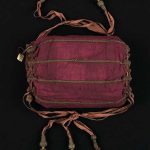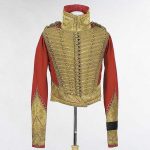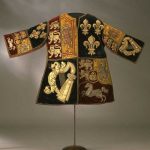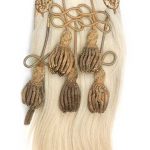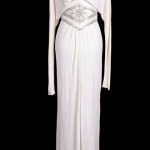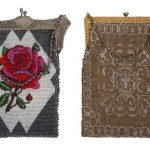Bullion or Purl is structurally a very long spring, hollow at the core; it can be stretched apart slightly and couched between the wraps of wire, or cut into short lengths and applied like beads. This thread comes in both shiny and matte versions and is used in goldwork. Reference: Wikipedia
Dress 1860–65 American Military-style decoration was recapitulated in civilian clothing, as seen in the front closure, shoulders, and cuffs of the bodice of this dress, although the actual decoration is here deliberately feminized. What might have been bullion fringe becomes delicate mother-of-pearl spangles.
Reference: The Metropolitan Museum of Art
Hat (naval bicorn) and case, metal / felt / plush / fabric, Australia, [1860-1900] Made by in Australia, Oceania, 1860-1900. Black plush bicorn hat, with gold bullion trim. Gold circular fastener for trim at side. Front and back trimmed in gold plush. Inside lined with red cloth and leather sweat band. Hat is stored in black japanned metal case in bicorn shape. Welded together from several pieces. Hinged clasp at bottom with off-centre lipped seam. Box opens from bottom. Ovoid ring fixed to top. Brass plaque fixed to side marked in incised script.
Reference: Museum of Applied Art and Sciences
Red silk muff trimmed with narrow gold ribbon and gold.
MEDIUM/TECHNIQUE Silk plain-weave with gold bullion ribbons, silk ribbon, silk and metal tassels, and silk lining DIMENSIONS 39.5 x 26 x 7.0 cm (15 9/16 x 10 1/4 x 2.75 in.) with ribbon and tassels added to height
Reference: Museum of Fine Arts Boston
A German General Officer of Hussars Jacket, worn by Ernest Augustus, King of Hanover circa 1850 HUSAREN-JACKE EINES DEUTSCHEN GENERAL-OFFIZIERS, UM 1850 of red cloth with gold bullion shoulder cords bearing two rank stars. Gold chain gimp and russia tracing braid decoration to front, the seams, collar and cuffs with gold Austrian wave lace of varying widths. Black crepe mourning band to left arm
Worn by Ernest Augustus, King of Hanover. There are several possible identifications potentially relevant to this lot. General officers of hussars of several European countries appear to have worn gold laced red jackets, all incorporating similar Austrian wave lace. Ernest Augustus, as Duke of Cumberland, was appointed Honorary Colonel of the Prussian 3rd Von Zeiten Hussars in 1823, a regiment traditionally dressed in red uniforms. In a portrait dated 1828 (see lot 2462) he is evidently depicted as a Prussian General Officer of Hussars, wearing a related red jacket (but with open cut away collar), the Prussian Order of the Red Eagle, and holding a Prussian pattern fur cap. In 1847 the Emperor of Austria named Ernest Augustus, King of Hanover Honorary Colonel of the 2nd Hussars of the Austrian army, apparently sending his personal tailor to Hanover to make a uniform for him. The jacket in this lot conforms generally to the pattern worn by Austrian generals of hussars prior to 1848. A date of after 1841 is suggested by the presence of the mourning band, worn on all the King’s uniforms after the death of Queen Frederica in that year. Another possible association could lie with the Hanoverian King’s Gendarmes, who wore gold laced red hussar jackets, or simply as a Hanoverian General officer of Hussars. Any association with the Duke of Cumberland’s service as an English General Officer of Hussars, which ceased with his acceding to the Colonelcy of the Royal Horse Guards in 1827, would appear to be ruled out by the later date of the jacket, the presence of gold bullion shoulder cords with German rank badges, and the absence of the laced side pockets usually found on English Hussar jackets, but apparently not on Hanoverian patterns. Contemporary illustrations of English General Officers of hussars show blue collars and cuffs.
Sold for 12,100 EUR at Sotheby’s in 2005
Red and blue silk velvet tabard, applied with cloth of gold and linen, embroidered with silver and silver-gilt thread, twist, bullion and purl in laid and couched work.
A tabard was a ceremonial garment bearing armorial devices worn by a herald. A herald’s original function was a courtly one, making royal proclamations and bearing ceremonial messages between monarchs. By the 18th century, they were also responsible for organising state ceremonies and processions such as weddings and funerals. The Herald also regulated and granted the use of coats-of-arms and other heraldic imagery. This tabard belonged to John Anstis the Elder, who was Garter King of Arms from 1719–44. The front, back and arms bear the royal arms in use between 1714 and 1801, representing England, Scotland, France, Ireland and Brunswick. The tabard was probably worn by Anstis’ son, John the Younger, also Garter King of Arms who held the office jointly with his father between 1727 and 1744 and until 1754.
Reference: © Victoria and Albert Museum
A Black Watch Officer’s Levee dress sporran The brass cantle embossed with thistles and figure of St Andrew, the bag covered in white horsehair, body with five bullion tassels, the rear of the bag covered in red leather and lined in doe skin, together with a part Black watch sporran lacking cantle (2)
Sold for £ 242 inc. premium at Bonham’s in 2019
[geolocator_show for=”GB”][ebayfeedsforwordpress feed=”http://rest.ebay.com/epn/v1/find/item.rss?keyword=bullion&categoryId1=175759&sortOrder=BestMatch&programid=15&campaignid=5338620288&toolid=10039&customid=pastimefashions-rss-uk-bullion&minPrice=50.0&listingType1=All&feedType=rss&lgeo=1″ items=”20″][/geolocator_show]
[geolocator_hide for=”GB”][ebayfeedsforwordpress feed=”http://rest.ebay.com/epn/v1/find/item.rss?keyword=bullion&categoryId1=175759&sortOrder=BestMatch&programid=1&campaignid=5338620289&toolid=10039&customid=pastimefashions-rss-us-bullion&minPrice=50.0&listingType1=All&feedType=rss&lgeo=1″ items=”20″][/geolocator_hide]
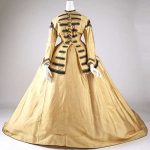
![Hat (naval bicorn) and case, metal / felt / plush / fabric, Australia, [1860-1900]](https://pastimefashions.com/wp-content/uploads/2019/11/bullion-hat-150x150.jpg)
